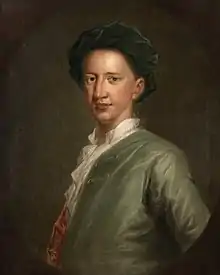Alexander MacFarlane (judge)
Alexander MacFarlane (c.1702 – 1755) was a mathematician, astronomer, merchant and slave-owner in Kingston, Jamaica. He became a Fellow of the Royal Society in 1747, considered to be an "ingenious and learned mathematician" and "one of the best mathematicians of the age".[1][2]

He was a benefactor of the Macfarlane Observatory at the University of Glasgow, where he bequeathed his instruments on his death in 1755.[3][4]
Early life and education
MacFarlane was the son of John MacFarlane of Macfarlane and Helen, daughter of Robert, second Viscount Arbuthnot.[1]
He graduated with an MA from the University of Glasgow in 1728.[5][6]
In 1735, he emigrated to Jamaica where he became a merchant, planter and slave-owner in Kingston. He later became assistant judge and member of the Legislative Assembly in Kingston.[6]
Death
He died unmarried in Jamaica in 1755. The instruments given by Macfarlane to the University of Glasgow were commissioned for repair by Scottish inventor James Watt, who became interested in steam engines whilst working on the instruments at the University.
In 1815, Macfarlane Street was opened in Glasgow after Macfarlane. The Macfarlane Observatory, the first purpose-built observatory in Britain, was named after him.[1]
At the time of Macfarlane's death, he was the owner of 791 enslaved people.[1] In September 2018, the University of Glasgow published a report titled 'Slavery, Abolition and The University of Glasgow' in its efforts towards a "programme of reparatory justice". It outlines significant gifts received by the University from people that derived wealth from slavery, which includes an acknowledgement of the value and intellectual capital of the instruments donated by Alexander Macfarlane.[7]
References
- "Summary of Individual | Legacies of British Slave-ownership". www.ucl.ac.uk. Retrieved 2020-02-10.
- Nelson, Louis P., author. (2016). Architecture and empire in Jamaica. ISBN 978-0-300-21100-9. OCLC 920017524.CS1 maint: multiple names: authors list (link)
- Bryden, D. J. (1970). "The Jamaican Observatories of Colin Campbell, F.R.S. and Alexander Macfarlane, F.R.S.". Notes and Records of the Royal Society of London. 24 (2): 261–272. doi:10.1098/rsnr.1970.0018. ISSN 0035-9149. JSTOR 531293.
- "Alexander MacFarlane (1702–1755) | Art UK". artuk.org. Retrieved 2020-02-10.
- Clarke, D. (David), 1936- author. Reflections on the astronomy of Glasgow : a story of some 500 years. ISBN 978-0-7486-8928-6. OCLC 872530179.CS1 maint: multiple names: authors list (link)
- "University of Glasgow :: Story :: Biography of Alexander Macfarlane". www.universitystory.gla.ac.uk. Retrieved 2020-02-10.
- Mullen, S (2018). "Slavery, Abolition and the University of Glasgow" (PDF). University of Glasgow. Retrieved 10 February 2020.